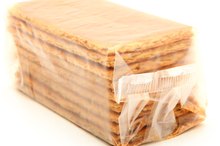What does fact checked mean?
At Healthfully, we strive to deliver objective content that is accurate and up-to-date. Our team periodically reviews articles in order to ensure content quality. The sources cited below consist of evidence from peer-reviewed journals, prominent medical organizations, academic associations, and government data.
The information contained on this site is for informational purposes only, and should not be used as a substitute for the advice of a professional health care provider. Please check with the appropriate physician regarding health questions and concerns. Although we strive to deliver accurate and up-to-date information, no guarantee to that effect is made.
Kids' Hypoglycemia Diet
A sugar called glucose is a body’s main source of fuel for its many functions. This sugar fuel enters the bloodstream when food breaks down in the digestive system. If your child’s blood sugar levels become abnormally low, he has a condition known as hypoglycemia and he may experience symptoms such as shakiness, headache, sudden behavior changes and confusion, according to the Lucile Packard Children’s Hospital. Adapting your child’s diet may help reduce his risk of seriously low blood sugar levels.
Considerations
Hypoglycemia is a symptom of an underlying condition. Hypoglycemia can occur once in a while, such as if a child overexerts herself without eating enough food for fuel, or it can be a recurrent problem. Although hypoglycemia in children is most often associated with diabetes, many other conditions can cause hypoglycemia. Your child could have a standalone condition called reactive hypoglycemia, where her symptoms occur within about 4 hours of eating a meal. Certain medications, tumors, a hereditary enzyme and hormonal deficiencies can cause hypoglycemia, according to the National Diabetes Information Clearinghouse. Long-term treatment methods for your child’s condition will depend on the underlying problem. For instance, a child with diabetes may not be helped by diet alone; she may also need to take insulin and constantly monitor her blood sugar.
- Hypoglycemia is a symptom of an underlying condition.
- Your child could have a standalone condition called reactive hypoglycemia, where her symptoms occur within about 4 hours of eating a meal.
Meal Frequency and Size
Sugar Intolerance in Children
Learn More
If your child has frequent episodes of hypoglycemia, you may help reduce his blood sugar dips by offering him a nutritious meal or snack every two to three hours, according to the University of Illinois McKinley Health Center. The size of your child’s meals and snacks is also an important part of keeping his blood sugar levels in check. Offering small meals such as a whole sandwich and some carrot sticks split into two separate mini meals will help glucose release into your child’s bloodstream at a slow and even pace.
- If your child has frequent episodes of hypoglycemia, you may help reduce his blood sugar dips by offering him a nutritious meal or snack every two to three hours, according to the University of Illinois McKinley Health Center.
- The size of your child’s meals and snacks is also an important part of keeping his blood sugar levels in check.
Important Nutrients
Include high fiber foods in every meal and snack you offer your child. Fiber, in foods such as fruits, vegetables and whole grain crackers, is slower to digest and helps extend process of carbohydrates breaking down into sugar. Include some fat and protein in each meal to further slow down the release and absorption of glucose. For instance, add turkey and cheese to whole-wheat crackers and top salads with nuts.
- Include high fiber foods in every meal and snack you offer your child.
- Include some fat and protein in each meal to further slow down the release and absorption of glucose.
“Quick Fix” Sugar
The Ideal Diet for 4-Year-Old Kids
Learn More
Ask your pediatrician to help you plan out when your child needs “emergency” sugar and what type of food or drink to offer your child if he starts showing serious hypoglycemia symptoms. In most cases, 1 cup of milk, 1 teaspoon of honey or sugar or ½ cup of any fruit juice or regular soft drink will help quickly boost your child’s blood sugar level, according to the National Diabetes Information Clearinghouse. Your pediatrician may recommend that you offer your child smaller doses if he is small. Because simple sugars do cause rapid blood sugar spikes and dips, keep candies, soft drinks and other sweets to a minimum in his diet under other circumstances.
- Ask your pediatrician to help you plan out when your child needs “emergency” sugar and what type of food or drink to offer your child if he starts showing serious hypoglycemia symptoms.
Related Articles
References
- TeensHealth from Nemours: What is Hypoglycemia?
- Jackson Siegelbaum Gastroenterology: Hypoglycemia Diet: Frank W. Jackson, M.D.
- American Diabetes Association. Hypoglycemia (Low Blood sugar)
- Joslin Diabetes Center. Avoiding Nighttime Lows
- Evans kreider K, Pereira K, Padilla BI. Practical Approaches to Diagnosing, Treating and Preventing Hypoglycemia in Diabetes. Diabetes Ther. 2017;8(6):1427-1435. doi:10.1007/s13300-017-0325-9
- American Diabetes Association. Hypoglycemia (Low Blood Glucose). Updated July 1, 2015.
- American Diabetes Association. Standards of Medical Care in Diabetes–2017. Diabetes Care. January 2017;40 (Supplement 1):S1-S2. doi:10.2337/dc17-S001.
- Mayo Clinic. Hypoglycemia. Mayo Clinic Staff. Updated February 16, 2018.
Writer Bio
Christa Miller is a writing professional with expertise in massage therapy and health. Miller attended San Francisco State University to earn a Bachelor of Arts in creative writing with a minor in journalism and went on to earn an Arizona massage therapy license.









